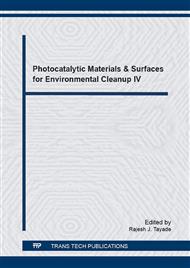[1]
G. Busca, S. Berardinelli, C. Resini, L. Arrighi, Technologies for the removal of phenol from fluid streams: a short review of recent developments., J. Hazard. Mater. 160 (2–3) (2008) 265–288.
DOI: 10.1016/j.jhazmat.2008.03.045
Google Scholar
[2]
S. Keav, A.E. de los Monteros, J. Barbier, D. Duprez, Wet Air Oxidation of phenol over Pt and Ru catalysts supported on cerium-based oxides: Resistance to fouling and kinetic modelling, Appl. Catal. B Environ., 150 (151) (2014) 402–410.
DOI: 10.1016/j.apcatb.2013.12.028
Google Scholar
[3]
A. Fujishima, K. Honda, Electrochemical Photolysis of Water at a Semiconductor Electrode, Nature. 238 (5358) (1972) 37–38.
DOI: 10.1038/238037a0
Google Scholar
[4]
A. Fujishima, T.N. Rao, D.A. Tryk, Titanium dioxide photocatalysis, J. Photochem. Photobiol. C Photochem. Rev. 1 (1) (2000) 1–21.
Google Scholar
[5]
S.G. Kumar, L.G. Devi, Review on modified TiO2 photocatalysis under UV/visible light: selected results and related mechanisms on interfacial charge carrier transfer dynamics, J. Phys. Chem. A. 115 (46) (2011) 13211–13241.
DOI: 10.1021/jp204364a
Google Scholar
[6]
X. Chen, S.S. Mao, Titanium dioxide nanomaterials: synthesis, properties, modifications, and applications, Chem. Rev. 107 (7) (2007) 2891–2959.
DOI: 10.1021/cr0500535
Google Scholar
[7]
D. Zhang, Enhancement of the photocatalytic activity of modified TiO2 nanoparticles with Zn2+. correlation between structure and properties, Russ. J. Phys. Chem. A. 86 (3) (2012) 489–494.
DOI: 10.1134/s0036024412030351
Google Scholar
[8]
M.A. Barakat, R. I. Al-Hutailah, E. Qayyum, J. Rashid, J.N. Kuhn, Pt nanoparticles/TiO2 for photocatalytic degradation of phenols in wastewater, Environ. Technol. 35 (1–4) (2014) 137–144.
DOI: 10.1080/09593330.2013.820796
Google Scholar
[9]
C.A. Emilio, M.I. Litter, M. Kunst, M. Bouchard, C. Colbeau-Justin, Phenol photodegradation on platinized-TiO2 photocatalysts related to charge-carrier dynamics, Langmuir. 22 (8) (2006) 3606–3613.
DOI: 10.1021/la051962s
Google Scholar
[10]
C. -H. Chiou, R. -S. Juang, Photocatalytic degradation of phenol in aqueous solutions by Pr-doped TiO2 nanoparticles, J. Hazard. Mater. 149 (1) (2007) 1–7.
DOI: 10.1016/j.jhazmat.2007.03.035
Google Scholar
[11]
M.S. Nahar, K. Hasegawa, S. Kagaya, Photocatalytic degradation of phenol by visible light-responsive iron-doped TiO2 and spontaneous sedimentation of the TiO2 particles, Chemosphere. 65 (11) (2006) 1976–(1982).
DOI: 10.1016/j.chemosphere.2006.07.002
Google Scholar
[12]
R.A. Shawabkeh, O.A. Khashman, G.I. Bisharat, Photocatalytic Degradation of Phenol using Fe-TiO2 by Different Illumination Sources, Int. J. Chem. 2 (2) (2010) 10.
DOI: 10.5539/ijc.v2n2p10
Google Scholar
[13]
M.A. Barakat, H. Schaeffer, G. Hayes, S. Ismat-Shah, Photocatalytic degradation of 2-chlorophenol by Co-doped TiO2 nanoparticles, Appl. Catal. B Environ. 57 (1) (2005) 23–30.
DOI: 10.1016/j.apcatb.2004.10.001
Google Scholar
[14]
X. Fu, L.A. Clark, Q. Yang, M.A. Anderson, Enhanced Photocatalytic Performance of Titania-Based Binary Metal Oxides: TiO2/SiO2 and TiO2/ZrO2, Environ. Sci. Technol. 30 (2) (1996) 647–653.
DOI: 10.1021/es950391v
Google Scholar
[15]
Z. Li, B. Hou, Y. Xu, D. Wu, Y. Sun, Hydrothermal synthesis, characterization, and photocatalytic performance of silica-modified titanium dioxide nanoparticles, J. Colloid Interface Sci. 288 (1) (2005) 149–154.
DOI: 10.1016/j.jcis.2005.02.082
Google Scholar
[16]
L. Yang, S. Luo, Y. Li, Y. Xiao, Q. Kang, Q. Cai, High efficient photocatalytic degradation of p-nitrophenol on a unique Cu2O/TiO2 p-n heterojunction network catalyst, Environ. Sci. Technol. 44 (19) (2010) 7641.
DOI: 10.1021/es101711k
Google Scholar
[17]
G. Li, N.M. Dimitrijevic, L. Chen, T. Rajh, K.A. Gray, Role of Surface/Interfacial Cu2+ Sites in the Photocatalytic Activity of Coupled CuO−TiO2 Nanocomposites, J. Phys. Chem. C. 112 (48) (2008) 19040–19044.
DOI: 10.1021/jp8068392
Google Scholar
[18]
D.P. Macwan, P.N. Dave, S. Chaturvedi, A review on nano-TiO2 sol–gel type syntheses and its applications, J. Mater. Sci. 46 (11) (2011) 3669–3686.
DOI: 10.1007/s10853-011-5378-y
Google Scholar
[19]
S. Xu, A.J. Du, J. Liu, J. Ng, D.D. Sun, Highly efficient CuO incorporated TiO2 nanotube photocatalyst for hydrogen production from water, Int. J. Hydrogen Energy. 36 (11) (2011) 6560–6568.
DOI: 10.1016/j.ijhydene.2011.02.103
Google Scholar
[20]
A.B. Isaev, G.A. Magomedova, N.A. Zakargaeva, N.K. Adamadzieva, Influence of oxygen pressure on the photocatalytic oxidation of the azo dye Chrome Yellow with TiO2 as the catalyst, Kinet. Catal. 52 (2) (2011) 197–201.
DOI: 10.1134/s002315841102008x
Google Scholar
[21]
A.B. Isaev, Z.M. Aliev, N.K. Adamadzieva, N.A. Alieva, G.A. Magomedova, The photocatalytic oxidation of azo dyes on Fe2O3 nanoparticles under oxygen pressure, Nanotechnologies Russ., 4 (7–8) (2009) 475–479.
DOI: 10.1134/s1995078009070088
Google Scholar
[22]
J. Bandara, C.P.K. Udawatta, C.S.K. Rajapakse, Highly stable CuO incorporated TiO2 catalyst for photo-catalytic hydrogen production from H2O, Photochem. Photobiol. Sci. 4 (11) (2005) 857–861.
DOI: 10.1039/b507816d
Google Scholar
[23]
T. -H. Lim, S. -M. Jeong, S. -D. Kim, J. Gyenis, Degradation Characteristics of NO by Photocatalysis with TiO2 and CuO/TiO2, React. Kinet. Catal. Lett. 71 (2) (2000) 223–229.
Google Scholar
[24]
M. Aceituno, C. D. Stalikas, L. Lunar, S. Rubio, D. Pérez-Bendito, H2O2/TiO2 photocatalytic oxidation of metol. Identification of intermediates and reaction pathways, Water Res. 36 (14) (2002) 3582–3592.
DOI: 10.1016/s0043-1354(02)00061-1
Google Scholar
[25]
C.C. Wong, W. Chu, The Hydrogen Peroxide-Assisted Photocatalytic Degradation of Alachlor in TiO2 Suspensions, Environ. Sci. Technol. 37 (10) (2003) 2310–2316.
DOI: 10.1021/es020898n
Google Scholar
[26]
M. Bertelli, E. Selli, Reaction paths and efficiency of photocatalysis on TiO2 and of H2O2 photolysis in the degradation of 2-chlorophenol, J. Hazard. Mater. 138 (1) (2006) 46–52.
DOI: 10.1016/j.jhazmat.2006.05.030
Google Scholar
[27]
C. Karunakaran, S. Senthilvelan, Fe2O3-photocatalysis with sunlight and UV light: Oxidation of aniline, Electrochem. commun. 8 (1) (2006) 95–101.
DOI: 10.1016/j.elecom.2005.10.034
Google Scholar
[28]
F.G. Gasanova, F.F. Orudzhev, Z.M. Aliev, A.B. Isaev, Influence of oxygen pressure on the photochemical oxidation of phenol, Russ. J. Phys. Chem. A. 86 (3) (2012) 495–497.
DOI: 10.1134/s0036024412030119
Google Scholar
[29]
A.B. Isaev, G.A. Magomedova, Z.M. Aliev, Sensitized photocatalytic oxidation of chrome brown on TiO2, Russ. J. Phys. Chem. A. 85 (11) (2011) 2041–(2043).
DOI: 10.1134/s0036024411110124
Google Scholar


